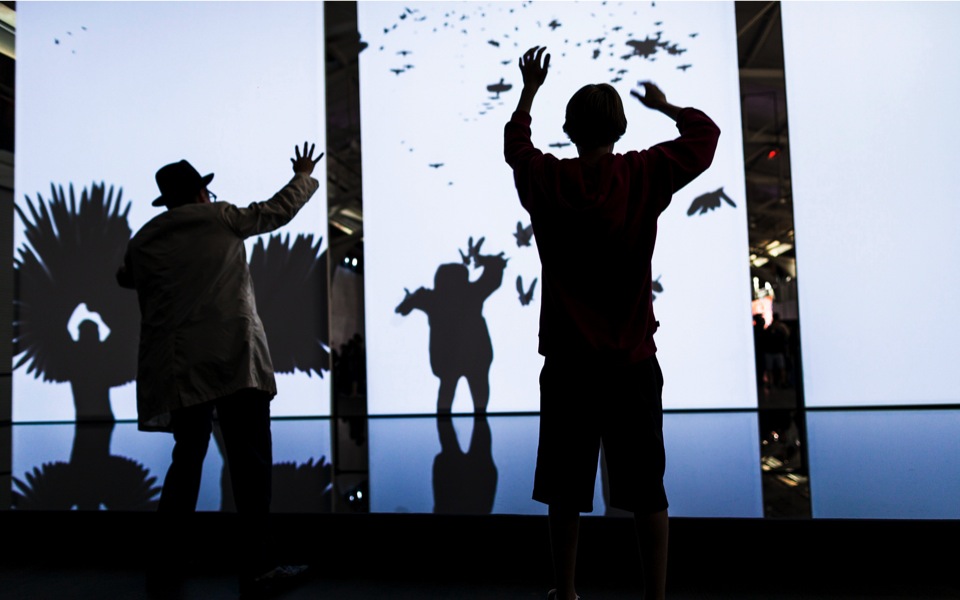Life in pixels: The history of the digital revolution

There are few areas of our lives that haven’t been impacted by digital media since the technology first started to become widely available in the 1970s, and the arts are no exception.
From October 20 until the beginning of next year, the Onassis Cultural Center in Athens will be inviting the public to see how visual artists, film directors, musicians, architects, designers and game programmers have embraced this technology and used it to push their creative boundaries. The touring exhibition “Digital Revolution” was first presented at London’s Barbican Center and is impressive in terms of volume – the show features over 110 exhibits – as well as substance, as it narrates the history of the digital arts while also anticipating what the future holds.
“The exhibition traces rather primitive environments and machinery all the way through the incredible possibilities of today’s artificial intelligence as well as areas currently in the initial stages of digital development,” said Christos Carras, executive manager of the OCC. “Each exhibit gets visitors involved, allowing for a certain level of interaction, even for those with no prior experience in the digital world. This makes the show accessible to all age groups, to the entire family.”
Following are some highlights from the show. The exhibition, which marks the Greek cultural center’s first collaboration with the Barbican Center, runs to January 10, 2016.
1975 – No product advertising
In 1975, Ed Roberts of Micro Instrumentation and Telemetry Systems (MITS) came up with the idea of developing a computer assembly kit. Before the product was finished, Popular Electronics magazine hit the newsstands with a photograph of the project’s empty case on its cover. An ad promoting the Altair computer – named after a “Star Trek” planet – at the price of 397 dollars also featured in the same issue. Roberts recruited two Harvard University students to adjust the BASIC programming language to Altair. The students were Paul Allen and Bill Gates. Six weeks later, the two of them created the Altair BASIC. It was the spark that set off the ensuing digital revolution.
1977 – Here comes Apple II
After developing Apple I, Steve Wozniak came up with a color computer in order to play Breakout, a game he had developed with Steve Jobs as a follow-up to Pong. The result was Apple II, the world’s first ever personal computer. The future of video games and computers had just converged.
1978 – ET phone home
Speech synthesizer Speak & Spell, the work of pioneer engineer Paul Breedlove, was the first of its kind, an attempt to simulate the range of the human voice through a complete computer circuit. While generally speaking syllable games are not particularly popular, it’s a different story when these involve a computer that speaks. What better proof of this than pop culture’s warm reception of Breedlove’s invention? British synthpop group Depeche Mode borrowed the device’s name for its first album, while ET hacked it and used it to call home.
1980 – What’s in a name?
Had its US distributors ignored their fears of malicious folk vandalizing the arcade games by replacing the P with an F, today we would still be talking about the legendary Puck-Man, as the game was originally known in its homeland, Japan. In any case, Pac-Man became the arcade game with the highest earnings of all time. By the end of the 1980s, Toru Iwatani’s masterpiece had surpassed “Star Wars” in terms of revenues. A completely new game, which attracted both female and male players, Pac-Man turned into a pop culture legend, demonstrating the power of videogame characters.
1985 – Partying with the mouse
Steve Jobs gave Sean Lennon an Apple Mac for his 9th birthday. Andy Warhol was also at the birthday party and at one point, Jobs began teaching the pop artist how to use the mouse. Less than a year later, Commodore presented the Amiga 1000, billed as the first multimedia computer, at the Lincoln Center for the Performing Arts in New York. The evening’s highlight was the creation of a live work of art on stage by Warhol, who used Amiga’s ProPaint software. The work’s subject was singer Debbie Harry.
2009 – Angry Birds
When Steve Jobs unveiled the iPhone in 2007, he promised this would be a device way ahead of the rest. He kept his word. The smartphone generation that followed perfectly incorporated the digital world into every aspect of our lives. These are not just phones: They provide our entertainment system and our social network; they are our link to the rest of the world. The application which best captures this monumental change is Rovio Entertainment’s Angry Birds. As billions of people began launching flightless birds against enraged pigs, digital culture turned into culture.
2013 – A dress for Lady Gaga
Celebrated for its innovative and provocative approach to fashion and wearable technology, fashion technology company Studio XO co-founded TechHaus with Lady Gaga during the campaign for the launch of the singer’s “Artpop” album in 2012. The parametric, sculptured, flying dress, known as Volantis and commissioned by the singer, was inspired by the album’s cover, executed in collaboration with acclaimed pop artist Jeff Koons. Inspired by a verse in Gaga’s song “Applause” – “One Second I’m a Koons, then suddenly the Koons is me” – the curvy, made-to-measure long black dress was printed on the world’s largest 3D printer, Materialise’s Mammoth Stereolithography.
Info: Onassis Cultural Center, 107-109 Syngrou, www.sgt.gr





